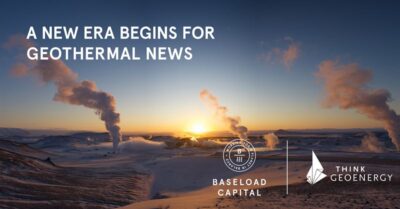Open innovation on multiple technologies could be key pushing geothermal development
 Well at the Newberry project site in Oregon (source: AltaRock Energy)
Well at the Newberry project site in Oregon (source: AltaRock Energy)
Applying multiple technologies and open innovation is key in the successful deployment of deep geothermal, so Aaron Mandell of AltaRock Energy in another opinion piece here on ThinkGeoEnergy.
In this third piece, published in collaboration with Aaron Mandell of AltaRock Energy, he describes on how open innovation in geothermal might be a key driver of development going forward.
He describes an increase in technical collaboration as the third (and final) element to the successful deployment of deep geothermal. By virtue of the limited market adoption of geothermal, the level of collaboration amongst U.S. technologists is extremely low compared to other industries. The DOE’s FORGE program (https://www.energy.gov/eere/forge/forge-home) is a step in the right direction, but not nearly enough. While FORGE is focused on basic research, more is needed to foster collaborative efforts around early-stage technologies that are ready for field deployment (i.e. the so called “valley of death”). This is especially important in an industry like geothermal where the lack of a strong innovation cycle cuts off the ‘feedback loop’ that would normally catalyze technology collaboration. Over time, this becomes a self-fulfilling prophecy; innovations slows, market demand slides and there is less and less opportunity for innovators to capitalize by partnering.
We see an opportunity to change this. The single most challenging hurdle for the field deployment of early-stage geothermal innovations is the cost of project development. This includes up-front regulatory and site evaluation expenses, site acquisition, permitting, construction and going-forward operations costs. It is far too burdensome for startups, that excel at high risk innovation, to also bear the cost of project development early on. If government funding sources are not suitable for this stage of the geothermal development cycle and traditional private-sector financing sources continue to see risk rather than return, collaboration is the only option.
Project sites like Newberry Geothermal (
http://www.newberrygeothermal.com/), in Oregon, can become platforms for the demonstration of multiple technologies. In doing so, the cost of project development is shared and spread over many more projects, accelerating the rate of deployment and reducing risk. In return for collaborating, technologists and entrepreneurs should encourage ‘open innovation’ where information is readily exchanged, improved upon by the collective and put into the public domain. This doesn’t mean
all technology development should be open-sourced, but there is much to be gained if
some is (for the same reason Tesla chose this path, see “all our patent are belong to you:
https://www.tesla.com/blog/all-our-patent-are-belong-you).
In the future, AltaRock will embrace this open technology philosophy by making geothermal project sites available for others to test new technologies and experiment with new solutions. We have already begun to seek out partnerships where the technology we’ve created can be leveraged by other emerging geothermal companies to create a force multiplier on innovation. Our hope is that, in turn, these collaborations will result in much more value flowing throughout the entire geothermal ecosystem – a rising tide floats all boats.


















